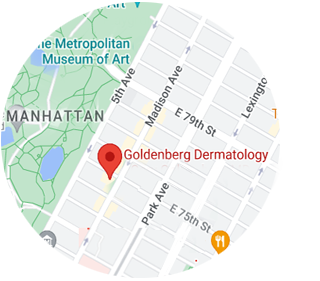Dr. Goldenberg discusses Protecting Your Kids from the Sun’s Harmful Rays on Beauty News NYC

By Dr. Gary Goldenberg
We all know that protecting oneself from sun’s harmful rays is important. Numerous scientific studies have shown that chronic and intermittent sun exposure is the greatest risk factor for melanoma and non-melanoma skin cancer. It’s also important to realize that just 15-30 minutes of sun exposure to the mid-day sun can cause a sunburn. We also know that having one sunburn before the age of 18, increases one’s risk of melanoma. That’s right, just a single sunburn is enough. Therefore, as a parent, I am very cognizant of the fact that it’s extremely important to start with sun protection early. And the easiest way to teach your child what to do is to set a good example.
Use Sunscreen:
While sunscreen labels are changing, the message is similar. My usual recommendation is a broad-spectrum sunscreen with UVA and UVB protection with SPF 30-50. There are sunscreens that are marketed specifically for kids. It turns out that these have the same ingredients and are slightly more expensive than those sunscreens sold for adults. Therefore, I recommend you apply the same sunscreen for your kids that you use yourself.
Sunscreens now come in different forms – lotions, sprays, rub-on sticks and creams. Since all the products with the same SPF theoretically work the same, it’s most important to choose the product that works best for your family.
One of the most important recommendations about sunscreen is to apply about 30 minutes before sun exposure and to reapply often. Also, it’s important to reapply sunscreen after each water activity, even if the sunscreen claims to be water-resistant. My recommendation to patients is to wear sunscreen every day, especially in the Spring-Fall months. This is certainly true for both adults and kids.
Sun-protective clothing:
It’s not enough to wear a cotton t-shirt at the beach. I recommend clothing certified with ultraviolet protective factor (UPF). Clothes with UPF are available for adults and kids. UPF is similar to SPF, in that the higher the number, the higher the level of protection. I recommend UPF of 40 or above. The sun protection in UPF clothing comes from several factors, including tightness of weave of the fabric, the type of material used, and specific dyes used to treat the clothing. If the clothing is stretched more than 10% or is wet, the UPF decreases. But I still recommend that all kids wear UPF clothing in the pool or ocean. Hats, shirts, pants, shorts and jackets are all available with UPF for kids.
Seek the shade/avoid mid-day sun:
Most people go to the pool, beach or do outdoor activities at the worst possible time – in the middle of the day. I recommend my patients avoid the sun between 11am and 3pm. The sun is the strongest during that period of time. If you prefer to be outside at that time, seek the shade as much as you can. If you are at the pool or beach, sit under the umbrella. If you are enjoying outdoor activities, try to do so in the most shaded area.
There is an app for that:
It’s not enough to look at the weather forecast to determine your risk of sunburn. There are apps for your smart phone that will tell you the UV index, which tells you the risk of having a sunburn. I advise all my patients to check the UV index before going out each day. If the risk is moderate and above, put on sunscreen, sun protective clothing and seek the shade.
Do it all:
The most important thing I tell patients is that you have to do it all – make sure your kids wear broad-spectrum sunscreen, reapply numerous times per day, wear sun-protective clothing, avoid mid-day sun, and seek the shade. It’s also important for parents to lead by example, to protect the entire family from sun’s harmful rays.
Dr. Gary Goldenberg is the Medical Director of the Dermatology Faculty Practice at The Mount Sinai Medical Center, and an Assistant Professor of Dermatology and Pathology at The Mount Sinai School of Medicine, New York City. Dr. Goldenberg received his medical degree from Temple University School of Medicine. He completed his Residency in Dermatology at Wake Forest University School of Medicine and Dermatopathology Fellowship at University of Colorado Health Sciences Center.
Board Certified in both Dermatology and Dermatopathology. Dr. Goldenberg is active in Dermatology research. His research interests include skin cancer, psoriasis, eczema, and acne. Dr. Goldenberg is the author of over 50 original articles, abstracts and book chapters. Dr. Goldenberg serves on the Editorial Boards and is a Reviewer for multiple dermatology journals, including Cutis, The Journal of Clinical and Aesthetic Dermatology, Journal of Clinical & Experimental Dermatology, Medscape, Skin and Aging, Archives of Dermatology, Journal of the American Academy of Dermatology, Journal of Dermatological Treatment, American Journal of Dermatopathology, and Journal of Cutaneous Pathology. He regularly lectures at the American Academy of Dermatology Meetings, as well as regional dermatology meetings.
Dr. Goldenberg is a member of the American Academy of Dermatology, American Society of Dermatopathology, and serves as the Treasurer and member of the Board of Directors for the Dermatologic Society of Greater New York. Dr. Goldenberg has also received numerous awards and honors including Alpha Omega Alpha Medical Honor Society, Mentor of the Year, Wake Forest Dermatology First Annual Dermatology Resident Teaching Award, and the American Academy of Dermatology’s Academic Dermatology Leadership Program.
Dr. Goldenberg is frequently sought after by the media on dermatology and dermatopatholoy topics and has appeared on CNN, Fox News Headline Health, ABC, NBC, Good Morning America Health, New York Daily News, and Wall Street Journal. Dr. Goldenberg maintains a wide range of clinical research interests including skin cancer, psoriasis, eczema, and acne.












Leave a Reply
Want to join the discussion?Feel free to contribute!